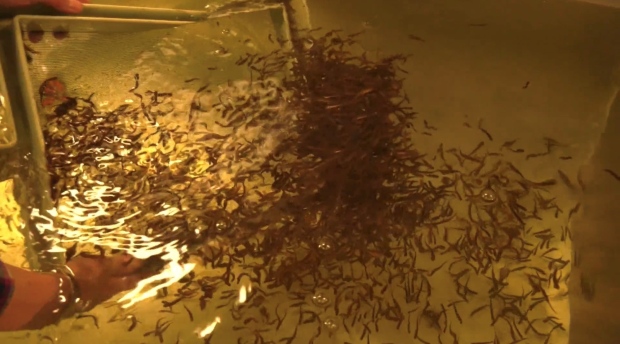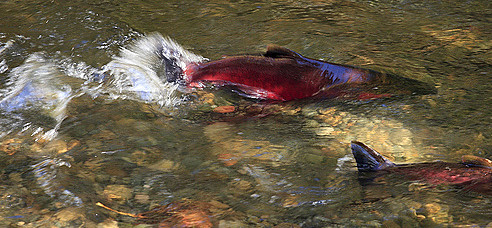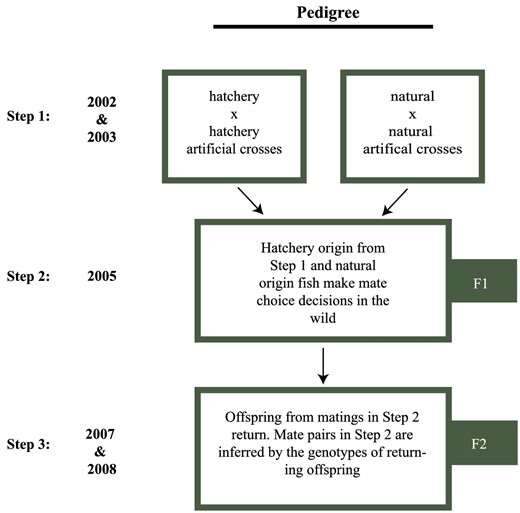Harper, wasn't it?Whatever happened to HEB anyway?
Fisheries habitat being steadily eroded, panel told
Federal government policy is failing, says Fisheries Department experts
Harper, wasn't it?Whatever happened to HEB anyway?
And as sure as this came true I can tell you that only a few years after the last hatchery gets closed the last salmon will die in these streams.Thanks for the reality check on the upper Fraser, Dave. Depressing. I think I'm gonna have to find a (small) bottle of Scotch after reading your post and stoke-up. I heard about 17 years ago we might end up here - and it's sad we have.
we carried out an extensive study of the early marine survival of the hatchery and wild juvenile chinook salmon. ... This six to 24 times difference in survival could negate an estimated increased egg-to-smolt survival of about 13% that is theorized to result through the use of a hatchery.
Accumulating data indicate that hatchery fish have lower fitness in natural environments than wild fish. This fitness decline can occur very quickly, sometimes following only one or two generations of captive rearing
I'd also note that this study found that hatchery steelhead smolts took 10 times longer to transit the river to the estuary than wild fish and had 3x the in river mortality.7%–13% of wild smolts and 30%–40% of hatchery smolts died in the first 3 km of the migration.Estimated survival from release to ocean entry was 71%–84% for wild fish and 26%–40% for hatchery fish and to exit from theStrait of Georgia system was 22%–33% for wild fish and 3.5%–6.7% for hatchery fish. A calculated 2.3-fold survival differenceestablished during the downstream migration
There is an abundance of scientific information that indicates hatchery reproduction genetically alters at least some salmonid species from there wild parents. This isn't even taking into account the loss of months or even years of in stream survival skills necessary for them to return as adults and spawn. Here are some links that support the hypothesis that hatchery reared fish have dramatically lower survival rates:
https://link.springer.com/article/10.1007/s10641-011-9783-5
Wild chinook salmon survive better than hatchery salmon in a period of poor production
https://www.ncbi.nlm.nih.gov/pmc/articles/PMC3352433/
Fitness of hatchery-reared salmonids in the wild
http://kintama.com/wp-content/uploa...rvival-difference-between-wild-and-hatche.pdf
Marine survival difference between wild and hatchery-reared steelhead trout determined during early down stream migration
I'd also note that this study found that hatchery steelhead smolts took 10 times longer to transit the river to the estuary than wild fish and had 3x the in river mortality.
In BC since the SEP hatcheries went on line anglers both in tidal and non-tidal water have reported perceived negative differences between hatchery salmon and the wild salmon they largely replaced; they were smaller, they migrated from the ocean to freshwater faster, they traveled deeper in the water column, they were less inclined to bite.
My own experience with cutthroat trout, coho and steelhead (hard to compare chinook since they are not marked) is that hatchery fish are usually significantly smaller, weaker (ie pull on the line) and visibly appeared less fit than wild fish . By less fit I mean thinner for their length, and more frequent damage to fins and skin.
Another concern is that hatchery fish by sheer weight of numbers may over compete for habitat, feed and spawning space, both in stream and in the ocean.

I have heard that Robertson Creek chinook stock have displaced or genetically contaminated (compromised) virtually every wild chinook stock on the central West Coast of the Island. Bob Hooton in his book Days of River past stated the entire chinook run on the Gold has been replaced by Robertson Creek stock. He called the Robertson Creek hatchery an example of how not to manage a hatchery.
Large-scale fish hatcheries hurting Chinook salmon populations, report finds
A new report is out on the health of B.C.’s southern Chinook salmon population, and findings are grim.vancouverisland.ctvnews.ca
Oh look tonight Robertson Creek is another target now.I have heard that Robertson Creek chinook stock have displaced or genetically contaminated (compromised) virtually every wild chinook stock on the central West Coast of the Island. Bob Hooton in his book Days of River past stated the entire chinook run on the Gold has been replaced by Robertson Creek stock. He called the Robertson Creek hatchery an example of how not to manage a hatchery.
I have heard that Robertson Creek chinook stock have displaced or genetically contaminated (compromised) virtually every wild chinook stock on the central West Coast of the Island. Bob Hooton in his book Days of River past stated the entire chinook run on the Gold has been replaced by Robertson Creek stock. He called the Robertson Creek hatchery an example of how not to manage a hatchery.
Aaron? Funny stuff, Derby - but strangely enough this does lead one down the path of understanding the ties between WWS and SkeenaWild, as I posted on another thread.... (and they started w steelheaders...)Oh Aaron perhaps you should just go to your Watershed Watch board meeting & peddle you nonsense...... As I see it if you and your band of MC clowns had your way you would shut everything down go wild only and then watch everything starve to death .. there is balance to be had perhaps meeting half way would be a great start...
Aaron? Funny stuff,


Exactly....and I would add after listening to Dr. Carl Walters, that the declines in salmon abundance are more largely attributed to increasing abundance of seals and sea lions beyond any historic levels. Unfortunately FN's harvest historically held the level of pinniped populations to about half where they are today. No amount of intervention to improve habitat, hatcheries or harvest appear to be able to arrest the decline. We are now in a death spiral that cannot be stopped using the current conventional wisdom approaches.With the $ collected from licenses/tags (won't get into the mass gov over spend in every other area) all hatcheries should have more funding and support. Especially where folks are donating their time (time is a persons most precious resource IMO).
There are really only 3 ways anyone can impact salmon stocks the 3 H's...... Habitat, Hatchery & Harvest.
The other 99% of the equation happens in the deep blue sea out of our control!
The Cons killed it.Whatever happened to HEB anyway?
and the "business-friendly", and conservative in everything but name - provincial Liberals under Gordon Campbell, calved the Fishery Renewal BC program circa 2002 nearly at the same time that the federal conservatives pulled HRSEP circa 2004:The Cons killed it.
